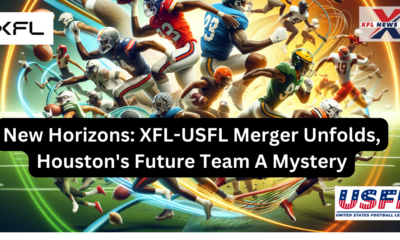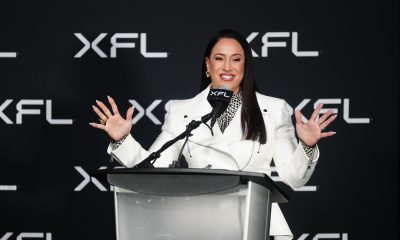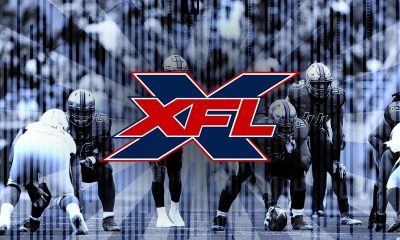
The XFL was first introduced and officially created on February 2, 2000 at a news conference in New York City by Vince McMahon and then-chairman of NBC Sports, Dick Ebersol. They pushed the concept as a more fun alternative to the NFL, which McMahon christened as the “no fun league.” Vince McMahon promised that The XFL would be 100% football, which raised a lot of questions on how the league would survive after other leagues that wanted to compete with the NFL have tried and have failed. There have also been questions about how legit the game play would be. XFL promised that they would be different and that they would bring the fans where they have never been before. Things like cameras in the huddles and on the sidelines, coaches would be hooked up with live microphone and locker rooms would be wired for sound and video before and after the game. Three TV Networks even bought into the hype. NBC, TNN and UPN would show games live on Saturday and Sundays. Players would all be paid the same base salary and the winning team would be receiving more money.
Originally, six teams were announced for the league but at a later date two more teams were announced. Los Angeles, Miami, Orlando, New York, San Francisco, and Washington were the first six teams that were announced. At a later date, Miami and Washington were taken out and were switched to Birmingham, Memphis, Chicago, and Las Vegas, making the total number of teams to eight. The league ran for one season having 10 games with strong ratings for the first week of games. The debut game had 54 million views, compared to the 84 million views that Super Bowl XXXV drew. The XFL officially debuted on February 3, 2001 in Las Vegas and Orlando. The world was eager to find out what the XFL was all about. The ratings were initially high, but as more and more games were being played, the interest from the fans and even the media died quickly. The biggest surprise of The XFL was the nicknames on the back of players’ jerseys. The name “He Hate Me” would be the most popular and most talked about name in the entire XFL. According to sources and fans, the sloppy play, boring announcers, and wrestling kind of feeling would soon doom the league. Attendance and merchandise sales were extremely successful at first, but quickly died down as well.
The league had an ever changing rulebook that included no fair catches (a major part of the marketing campaign), no point-after kicks and the controversial opening scramble. The scramble replaced the coin toss at the beginning of games. One player from each team would line up on the 30 yard line, and fight to retrieve a football sitting at midfield. At the sound of the whistle, those players would rush to the ball and whoever would get the ball would get to choose their possession. This would result in several injuries. The players who would get injured would include Orlando Rage’s free safety Hassan Shamsid-Deen, who separated his shoulder in the very first scramble. As a results of the injury, he missed the remainder of the season. The constant changing of the rules would eventually hurt the quality of how the teams would play and perform well. Coaches and players struggled with adjusting to these changes. This would eventually lead to games having very little to a really limited and bad offensive production that was criticized as slow, sloppy and uninteresting by both the fans and the media.
Another factor that would eventually lead to the league’s demise and the quality of the games being really bad were the players. There were 475 players involved in the inaugural season’s draft and each team had a roster of 38 athletes, compared to 53 in the NFL, resulting in a lack of depth in non-quarterback positions. Most eligible players that were included in the inaugural season’s draft came from either the CFL, the Arena Football League, NFL Europe, retired NFL players or previous college players who had gone undrafted by the NFL but had not yet signed with another league. The presentation of the league was a source of controversy. McMahon was ridiculed by mainstream sports media, due to his connections to fake pro-wrestling. This perception followed the XFL as few mainstream sports media entities would cover it, and the ones that did were not kind to the organization.
A February 2001 edition of Sports Illustrated featured the XFL on the cover with the description being “sleazy gimmicks and low-rent football.” McMahon then appeared on longtime football analyst Bob Costas’ program “On the Record” in the middle of the season. McMahon’s confrontational and defiant attitude only lowered public opinion of the league. Costas later commented his feelings on the encounter with McMahon and the league as a whole, as seen below:
“Everything about it screamed to me schlock and crap. Everything that subsequently occurred validated that impression.”
The addition of wrestling elements such as storylines, commentators playing characters and skits added to the reasons the league was ridiculed and why the league eventually closed its doors as well. Every team had scantily clad cheerleaders that danced provocatively and were encouraged to participate in storylines and become romantically involved with players. It was an environment fostered by McMahon in an attempt to increase viewership according to the ESPN “30 for 30” film documentary called “This Was the XFL.” The use of storylines, appearances by WWE personalities such as McMahon and The Rock and games being commentated by wrestling announcers Jesse Ventura, Jim Ross and Jerry Lawler damaged the reputation of the league and caused fans and media figures to believe the action was fake and pre-determined like professional wrestling.
Accidents also plagued the season and the league. During the Los Angeles Xtreme versus Chicago Enforcers game in week two, a power outage occurred due to a generator not being fueled. The game was off the air for 15 minutes before the problem was fixed, causing a drop in viewership. The same game then went into double overtime, and pushed back the airing of “Saturday Night Live” by 45 minutes, angering its creator and influential NBC personality Lorne Michaels.
Teams faced a large number of injuries during the season, with two running their third string quarterback by the end of the season. These issues led to a loss of $35 million dollars by the end of the season and the ending of the league. It was considered a flop by sports media and those involved with professional football and even McMahon himself called it a “colossal failure.”
However, some aspects of the XFL lived on after its demise. While it wasn’t the first to do so, it popularized the use of the sky cam, which was an overhead shot that focused on the action behind the offense. It was an acclaimed choice and was picked up by the NFL, becoming a staple of their camerawork. They also used the Bubba cam, which was a cameraman running on the field and getting up close with the action. It did result in a couple of injuries, but was applauded for making the presentation look like a video game.
There were some notable players to come out of the XFL as well, including Tommy Maddox and Rod “He Hate Me” Smart. Maddox was the quarterback for the Los Angeles Xtreme and led them to win the final game of the season also known as the Million Dollar Game. He was the league MVP. He then signed with the Pittsburgh Steelers in 2002, leading them to a 10-1-5 season. He was injured after two more seasons and became a backup to Ben Roethlisberger. He was part of the team when they won Super Bowl XL in 2005. Orlando Rage had the regular season’s best record at 8-2 and they hosted the playoff games.
Rod Smart played for the Las Vegas Outlaws in the XFL and became popular for the phrase on his jersey, “He Hate Me.” It became the highest selling jersey in the league.
Smart explained the meaning of the phrase in 2004, as seen below:
“Basically, my opponent is going to hate me. After I win, he’s gonna hate me. It is what it is. It’s a saying I was saying when I’d feel something wasn’t going my way.”
He then went on to play for the Philadelphia Eagles for a season, and then joined the Carolina Panthers from 2002 to 2006, winning an NFC Championship in 2003 and playing in Super Bowl XXXVIII. In total, 39 XFL players went on to play in the NFL. Nine of them played in a Super Bowl and six of them won.
The XFL was a failed experiment that was a spectacle for sports media and fans, and provided innovations in camera work and noteworthy players to the NFL. The 2001 season was the only season the XFL has had. Although it was promised that the league will be having two seasons, NBC pulled out of its broadcast contract for the XFL after the inaugural season, citing the poor viewership and this would eventually lead to the league’s demise. WWE owner Vince McMahon initially stated that the XFL would continue without NBC and he even proposed the addition of expansion teams, but unfavorable demands of the league by UPN hastened the XFL’s demise, and the league ceased operations entirely on May 10 2001, a month after the championship game also known as the Million Dollar Game. The XFL will always be remembered for their unique kind of football.
McMahon maintained control of the XFL brand after the league ceased operations, and on January 25, 2018, he announced the return of the XFL with a target relaunch date of early 2020. The revival will be owned by McMahon’s Alpha Entertainment, a company separate from the WWE and now that we know that the XFL will be coming back and it will be relaunched in 2020, it will be interesting to see what approach Vince McMahon will take and what improvements he will make to successfully run the XFL this time around. The first incarnation of the league left behind a legacy of missteps, questionable decisions and failure, but added new innovations to the game that the NFL uses to this day.
Unleash the Action: Sign up for XFL Insider and Fuel Your Passion for Football!

USFL and XFL Merger: A Deep Dive into the Historic Collaboration
Latest Podcast
-


XFL Podcast
/ 1 year agoXFL-USFL Merger Insights: Houston’s Future, Draft News, Player Movement – Ep. 216
Welcome to Episode 216 of the “XFL Week In Review,” your premier destination for...
By Mark Perry







